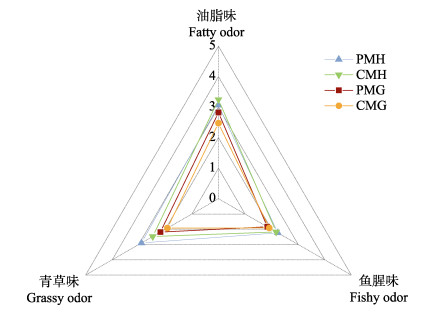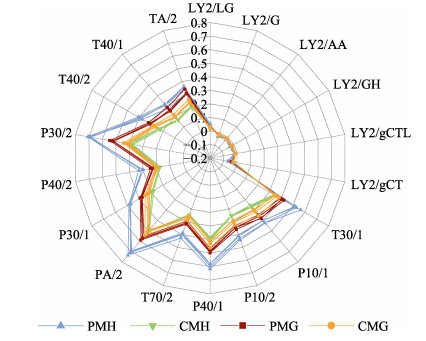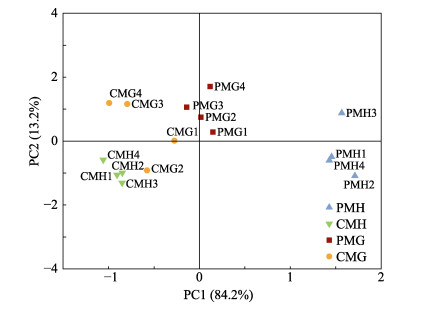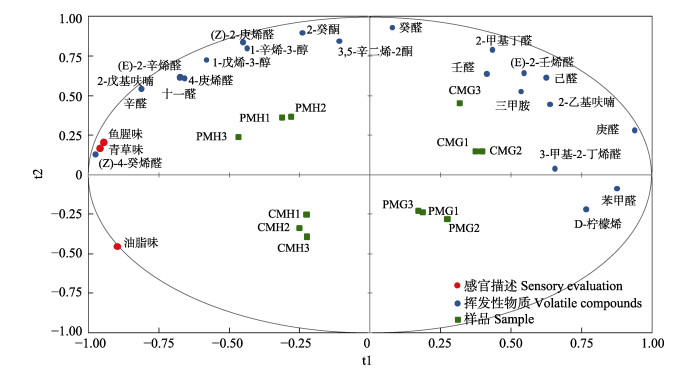2. 上海水产品加工及贮藏工程技术研究中心 上海 201306;
3. 农业农村部水产品贮藏保鲜质量安全风险评估实验室 上海 201306
2. Shanghai Engineering Research Center of Aquatic-Product Processing & Preservation, Shanghai 201306, China;
3. Laboratory of Quality and Safety Risk Assessment for Aquatic Products on Storage and Preservation, Ministry of Agriculture and Rural Affairs, Shanghai 201306, China
中华绒螯蟹(Eriocheir sinensis)又名清水蟹、大闸蟹、河蟹,在我国水产养殖中占有重要的地位(农业农村部渔业渔政管理局等, 2021)。中华绒螯蟹因其滋味鲜美、香气馥郁而广受消费者的喜爱。渔光一体养殖模式(photovoltaic fishery breeding mode, PM)是一种传统光伏发电和池塘养殖相结合的养殖模式(包婧文等, 2016)。这种养殖模式不仅能提高土地资源利用率,还能获得光伏发电产生的经济效益,是一种效益最大化的新型绿色养殖模式(郝多等, 2016)。
在不同养殖模式下,水体环境发生变化,温度、pH值、盐分以及溶解氧等因素都会随之发生改变(李林, 2005),以致对水产品的气味造成差异(王赛, 2012; Podduturi et al, 2017; Shao et al, 2014)。研究表明,渔光一体养殖模式会使水体pH、温度下降、氮磷比升高,对水草生长有积极影响(钱华政等, 2021),也可以使中华绒螯蟹的平均质量上升(赵博礼, 2019; 牛超等, 2021)。现有研究主要集中于探讨中华绒螯渔光一体养殖模式对水体环境及河蟹生长状况的影响,但鲜有对渔光一体养殖模式的河蟹气味品质进行研究。中华绒螯蟹的营养品质和风味品质是消费者最重要的关注点,气味也是评价中华绒螯蟹风味品质的重要指标。在不同养殖地区、不同养殖模式下,中华绒螯蟹的滋味品质、气味品质都有较大的差异(郭宏慧等, 2022),在中华绒螯蟹雌蟹的可食部位中,肝胰腺及性腺是提供特征香气的主要部位(张娜, 2008),其气味浓郁的特点能更利于区分2种养殖模式之间的差异,故选取这2个可食部位进行研究。
本研究探讨了渔光一体养殖模式与普通池塘养殖模式(common pond breeding mode, CM)对中华绒螯蟹气味品质的影响,选取中华绒螯蟹雌蟹肝胰腺和性腺进行人工感官评价及测定生长性状、基本营养成分、电子鼻和挥发性化合物,对2种养殖模式的中华绒螯蟹肝胰腺和性腺的气味进行综合评价,以期为优化及推广中华绒螯蟹的渔光一体养殖提供理论依据。
1 材料与方法 1.1 材料与仪器中华绒螯蟹:2020年11月,从江苏南京通威省级精品渔业园渔光一体养殖模式和普通池塘养殖模式各采集雌蟹30只,2种养殖模式的蟹均为同种蟹苗,养殖周期一致,饲喂同种饲料。中华绒螯蟹捕捞后立即用稻草捆绑降低耗能,放置于装有冰袋的泡沫箱中立即运回实验室。
主要仪器设备:全自动凯氏定氮仪(FOSS公司,Kjeltec 8400,丹麦);索氏抽提仪(FOSS公司,Soxtec,丹麦);马弗炉(上海精宏公司,SXL-1002);电子鼻(Alpha M.O.S公司,Fox 4000 Sensory Array Fingerprint Analyze,法国);气质联用仪(Agilent质谱公司,6890-5975B,美国);集热式恒温加热磁力搅拌器(河南省巩义市予华仪器有限责任公司,DF-101S);手动进样手柄、萃取头[碳分子筛(CAR)/二甲基硅氧烷(PDMS),涂层厚度为75 μm] (Supelco公司,美国);40 mL顶空萃取瓶(上海安谱科学仪器有限公司)。
1.2 实验方法 1.2.1 样品制备河蟹样品:将2种养殖模式的中华绒螯蟹从箱中取出,用清水洗净河蟹表面,再用纸将水分吸干后解剖,去除腿和蟹壳,将肝胰腺和性腺剥下,分别放入不锈钢蒸锅内蒸制30 min,稍冷却后装入塑封袋中放置于–40 ℃冰箱待后续指标测定。
1.2.2 生长状况测定采样时称量河蟹体重(BW) (精确到0.1 g)、肝胰腺和性腺组织质量(精确到0.1 g),测量壳长(CL) (精确到0.1 mm),肥满度(K)、肝胰腺指数(hepatosomatic index, HSI)、性腺指数(gonadosomatic index, GSI)参考唐永成等(2019)计算方法,具体公式如下:
| $ 肥满度K = {\rm{BW/(CL)}}^{3}×100^{ } $ | (1) |
| $ 性腺指数(\text{GSI,%}) = 性腺质量/{\rm{BW}}×100 $ | (2) |
| $ 肝胰腺指数(\text{HSI,%}) = 肝胰腺质量/{\rm{BW}}×100 $ | (3) |
水分测定参照GB 5009.3-2016《食品中水分的测定》中的直接干燥法;粗蛋白测定参照GB 5009.5-2016《食品中蛋白质的测定》中的凯氏定氮法;粗脂肪测定采用GB 5009.6-2016《食品中脂肪的测定》中的索氏提取法;灰分测定参照GB 5009.4-2016《食品中灰分的测定》。
1.2.4 人工感官评价参照从娇娇等(2020)的方法,选取10名经验丰富的感官员(5男5女)对中华绒螯蟹肝胰腺和性腺进行感官评定,评定内容为气味的3种特征:油脂味、青草味和土腥味,评分为5分制,0=气味不存在;1=气味很弱;2=气味弱;3=气味中等;4=气味强;5=气味很强。
1.2.5 电子鼻感官评价用绞肉机将肝胰腺和性腺样品搅碎至均匀后,分别称取(1.000 0±0.000 1) g至电子鼻进样瓶后上机测定。进样参数:将进样瓶于50 ℃平衡10 min后,以洁净干燥空气为载气,流速150 mL/min,进样体积2 500 μL,注射针温度60 ℃,数据采集时间120 s,延滞时间10 min。
1.2.6 挥发性化合物测定参考顾赛麒等(2013a)的方法,肝胰腺样品直接称取(5.000 0±0.000 1) g至进样瓶中,性腺样品以1∶1加入0.8% NaCl溶液后匀浆,称取均质后的性腺混合物(10.000 0±0.000 1) g至进样瓶中。将装有样品的顶空瓶置于水浴锅中恒温10 min后,插入SPME针管,伸出75 μm CAR/PDMS萃取头,在60 ℃水浴条件下吸附45 min。待吸附结束,取出萃取头,插入GC-MS进样口,240 ℃解吸5 min,热脱附进行GC-MS检测。
GC-MS条件:色谱柱为DB-5MS弹性毛细管柱(60.00 m×0.32 mm,1 μm);不分流模式,起始柱温为40 ℃,保留3 min,然后以4 ℃/min升至100 ℃,保留2 min;再以6 ℃/min升至180 ℃,无保留;接着以10 ℃/min升至250 ℃,保留5 min。载气为氦气,流量1.0 mL/min;汽化室温度240 ℃。质谱条件:电子电离(electron ionization,EI)离子源;电子能量为70 eV,灯丝发射电流为200 μA,离子源温度为200 ℃,检测器电压为1.2 kV。
1.2.7 挥发性化合物的定性和定量方法定性方法:挥发性物质谱图采用NIST 2008数据库进行定性分析,仅报道正反匹配度均大于800 (最大值为1000)的结果。
定量方法:将10 μL原始含量为1 000 mg/mL的内标物2, 4, 6-三甲基吡啶(TMP)加入样品中,通过计算待测挥发物与TMP的峰面积之比求得其含量(假定各挥发物的绝对校正因子为1.0),计算公式如下:
| $ \begin{array}{l}含量\text{ }/(\text{ng}/\text{g})=\\ \frac{峰面积比例 (挥发物/\text{TMP})\times 10{\rm{ \mathsf{ μ} }}\text{g}(\text{TMP})}{5\text{g}(大闸蟹样品)}\times {10}^{3}\end{array} $ | (4) |
本研究所有数据使用SPSS 20.0软件进行统计分析,结果均以平均值±标准差(Mean±SD,n=3)表示,采用ANOVA分析,数据进行正态分布检验,符合正态分布的多重比较采用Duncan’s法,不符合正态分布的用Kruskal-Wallis检验,差异显著性为P < 0.05。主成分分析使用Origin 2022进行处理分析。偏最小二乘法分析使用XLSTAT 2016进行处理分析。
2 结果与分析 2.1 生长性状及基本营养成分分析中华绒螯蟹雌蟹的生长性状如表 1所示,2种养殖模式下的平均质量、肥满度、肝胰腺指数并无显著差异(P > 0.05),PM组性腺指数[(11.89±0.43)%]显著高于CM组[(11.02±0.14)%] (P < 0.05)。表 2为2种养殖模式下雌蟹的基本营养成分,在肝胰腺中PM组的粗脂肪、粗蛋白含量显著高于CM组(P < 0.05)。在性腺中,PM组粗脂肪含量[(15.20±0.72)%]显著高于CM组[(14.27±0.50)%] (P < 0.05),其他并无显著性差异(P > 0.05)。生长性状及基本营养成分结果表明,渔光一体养殖模式能使肝胰腺具有更高的粗脂肪和粗蛋白含量,且对性腺的生长具有促进作用。
|
|
表 1 2种养殖模式下中华绒螯蟹雌蟹肝胰腺及性腺的生长性状 Tab.1 Tissue indices of hepatopancreas and gonads of E. sinensis in two breeding modes |
|
|
表 2 2种养殖模式下中华绒螯蟹雌蟹肝胰腺及性腺的基本营养成分/% Tab.2 Proximate composition of hepatopancreas and gonads of E. sinensis in two breeding modes/% |
图 1为2种养殖模式下中华绒螯蟹雌蟹肝胰腺和性腺的气味感官评价雷达图,由图 1可知,在肝胰腺和性腺中,主要表现为青草味、鱼腥味和油脂味。其次,肝胰腺的气味评价高于性腺,可能是由于肝胰腺具有更高的粗脂肪含量。PM组的肝胰腺和性腺的青草味均显著高于CM组(P < 0.05),油脂味和鱼腥味也呈现相似的结果,均为PM组大于CM组。感官评价结果表明,渔光一体养殖模式能增强中华绒螯蟹雌蟹肝胰腺和性腺的青草味和油脂味。

|
图 1 2种养殖模式下中华绒螯蟹雌蟹肝胰腺及性腺的气味感官评价雷达图 Fig.1 Radar chart for sensory taste evaluation of hepatopancreas and gonads of E. sinensis in two breeding modes |
图 2为2种养殖模式下中华绒螯蟹雌蟹肝胰腺和性腺的电子鼻传感器雷达图,18根传感器对不同样品的挥发性化合物有不同的响应值,肝胰腺和性腺不同气味物质主要在传感器T30/1、P10/1、P10/2、P40/1、T70/2、PA/2、P30/1、P40/2、P30/2、T40/2、T40/1和TA/2上响应值的差异较大,说明电子鼻对2种部位的气味轮廓区分效果较好。上述12根传感器的敏感物质类型包括氮氧化物和酮类等(Wu et al, 2016)。在肝胰腺中,传感器合物、碳氧化合物、碳氢化合物、胺类、氨类、硫化P40/1、T70/2、PA/2、P30/1、P40/2、P30/2和T40/2的响应值差异较大,其主要敏感物质为碳氢化合物及胺类、酮类(吴娜, 2017),表明这些物质可能是导致2种养殖模式雌蟹肝胰腺气味轮廓差异的主要原因。在性腺中,传感器P30/2、T40/1和TA/2的响应值差异较大,其主要敏感物质为硫化氢、酮类及乙醇(吴娜, 2017),这些物质可能是导致2种养殖模式雌蟹性腺气味轮廓差异的主要原因。

|
图 2 2种养殖模式下中华绒螯蟹雌蟹肝胰腺和性腺的电子鼻传感器雷达图 Fig.2 Radar chart for electronic nose sensor of hepatopancreas and gonads of E.sinensis in two breeding modes |
主成分分析是将电子鼻18根传感器响应的特征向量矩阵数据转化和降维,并对降维后的特征向量进行线性分类,最后将分类结果以PCA散点图的形式展现出来。第一、第二主成分贡献度之和表明样品在PC1和PC2的上的完整性,其值越大表明信息越完整(Dora et al, 2016)。图 3为2种养殖模式下中华绒螯蟹雌蟹肝胰腺和性腺滋味轮廓PCA图,PC1和PC2之和为97.4%,表明2种养殖模式的可食部位均能很好地区分。PMH的数据主要分布在Y轴右侧,CMH的数据在Y轴左侧,2组差异主要体现在PC1上。PMG与CMG差异也体现在PC1上,但差异比肝胰腺小。电子鼻主成分分析结果表明,2种养殖模式对雌蟹肝胰腺的气味轮廓具有较为显著的影响。

|
图 3 2种养殖模式下中华绒螯蟹雌蟹肝胰腺及性腺的气味轮廓主成分分析图 Fig.3 Principal component analysis plot of hepatopancreas and gonads of E. sinensis in two breeding modes |
表 3为2种养殖模式下中华绒螯蟹雌蟹肝胰腺和性腺挥发性成分的含量,本研究鉴定得到9大类共65种物质,其中,肝胰腺分别鉴定出44种(PM组)和33种(CM组)物质,性腺分别鉴定出了31种(PM组)和47种(CM组)物质。在肝胰腺中,PM组总挥发性物质的含量[(70.53±2.91) ng/g]显著高于CM组[(16.63±0.73) ng/g] (P < 0.05),是CM组的4.2倍;而在性腺中,2种养殖模式的总挥发性物质含量并无显著差异(P > 0.05)。
|
|
表 3 2种养殖模式下中华绒螯蟹雌蟹肝胰腺和性腺挥发性化合物的含量 Tab.3 The volatile compounds in hepatopancreas and gonad of female E. sinensis in two breeding modes |
2种养殖模式下中华绒螯蟹雌蟹(PM组和CM组)肝胰腺中的挥发性物质主要以醛类(22.59%、21.83%)、醇类(21.79%、28.14%)和烷烃类(37.03%、38.00%)为主,性腺以醛类(13.01%、31.19%)、芳香类(7.54%、3.99%)、醇类(8.18%、9.69%)和烷烃类(67.49%、44.20%)为主。进一步分析表 3可知,己醛等22种挥发性物质在2种养殖模式的雌蟹肝胰腺和性腺中同时被检出,2-甲基-2-丁烯醛等14种物质仅在肝胰腺中被检出,2-戊烯醛等14种物质仅在性腺中被检出。
醛类物质可通过脂类过氧化、美拉德反应和氨基酸的Strecker降解反应而形成,其阈值较低,对水产品的风味有重要贡献(Wu et al, 2016)。在肝胰腺中,PM组的己醛、庚醛、辛醛、壬醛的含量显著高于CM组(P < 0.05),而在性腺中,则是CM组含量较高。这些饱和的直链醛会使河蟹具有鱼腥味和青草味,其中,己醛被认为对河蟹风味具有重要贡献,是评价水产品品质的可靠指标(Mu et al, 2021)。苯甲醛是一种带有甜杏仁味的挥发性物质,多次在海蟹中被检测到(韩姣姣等, 2016),是一种重要的挥发性物质。本研究中,PM组的苯甲醛含量显著高于CM组(P < 0.05)。不饱和的支链醛类会使水产品带有脂肪味和青草味(Chen et al, 2021),2-甲基丁醛是氨基酸在高温下微生物降解的美拉德反应产物(高先楚, 2015),能产生令人愉悦的油炸脂肪味,2-甲基2-丁烯醛是松露气味的组成成分(Chen et al, 2021),4-庚烯醛是2, 6-壬二烯醛降解产生的,具有脂肪味和奶油味(付雪艳等, 2018),这几种物质在PMH中均有检出,是PMH特有的挥发性物质。PMH中醛类物质含量较高可能是由于其粗脂肪含量比CM组更高,加热过程中脂质降解产生了大量醛类,这也是电子鼻检测中PMH信号值比其他组高的原因。
酮类物质多由多不饱和脂肪酸的热氧化或降解、氨基酸降解或微生物氧化产生(Guo et al, 2019),能赋予水产品独特的水果香气,其香味随着碳链的延长而增加,且阈值较低(Shao et al, 2014),对河蟹风味具有较大的贡献。肝胰腺中共检测出3种酮类物质(3, 5-辛二烯-2-酮、2-辛酮和2-癸酮),其含量均为PMH显著高于CMH (P < 0.05);性腺中共检测出4种酮类物质(丙酮、3-戊酮、3, 5-辛二烯-2-酮和2-癸酮),其中PMG的3-戊酮含量显著高于CMG,丙酮和2-癸酮仅在CMG中检出,这2种物质都是脂质氧化产生的,具有果香味。王锡昌等(2014)研究表明,烯酮类化合物3, 5-辛二烯-2-酮具有特别的植物芳香,类似牛奶和番茄的气味,其含量在PMH中最高,这可能也是PMH在感官评价中青草味评分较高的原因之一。
醇类物质的阈值较高(Wu et al, 2018),但在肝胰腺中其含量也高,占总挥发性物质的20%~30%,对河蟹的风味有一定的贡献。本研究中,肝胰腺检出8种醇类物质,性腺检出7种醇类物质。不饱和醇通常比饱和醇具有更低的阈值,可能对整体风味有更大的影响。1-辛烯-3-醇是一种具有蘑菇香气的挥发性物质,主要来源于亚油酸氢过氧化物的降解产物(韩姣姣等, 2016; 王福田等, 2022),普遍存在于水产品中,PMH中1-辛烯-3-醇的含量显著高于CMH,但在性腺中,则是CMG含量更高。
芳香类物质由带苯环的氨基酸降解产生(倪逸群等, 2017),本研究共检出3种芳香类物质,这些物质可能是导致样品带有刺激性异味的原因,但因其阈值较高,对河蟹的风味影响较小。
呋喃类物质被认为是水产品中重要的杂环化合物,它是由脂肪氧化和氨基酸降解产生的(吴娜, 2017)。本研究中检测到2-乙基呋喃和2-戊基呋喃2种呋喃类物质,2种养殖模式的肝胰腺中均有检出,而性腺仅存在CM组中。2-乙基呋喃是由亚麻酸降解生成的一种物质,可作为脂质氧化的指标,会产生令人不愉悦的辛辣气味(顾赛麒等, 2014),因其阈值较低,对河蟹风味的形成有影响,CM组的肝胰腺和性腺中2-乙基呋喃的含量都高于PM组(P < 0.05)。2-戊基呋喃是具有青草味和豆香味的油脂氧化产物(付雪艳等, 2018),是PMH中特有的呋喃类物质,有助于提升PMH的青草味。
含氮/硫化合物可能是导致河蟹异味的主要化合物,这些物质带有令人不适的硫臭味和氨味,其含量可能较低,但对河蟹异味具有重要影响。本研究中,共检出3种含氮化合物(三甲胺、吡啶和2-戊基吡啶),2种含硫化合物(二甲基二硫和噻吩)。三甲胺是水产品中重要的鱼腥味物质,也是评价水产品新鲜度的指标(Shao et al, 2014; Mu et al, 2021),在CMG中,三甲胺的含量是PMG的17倍,高含量的三甲胺可能是导致CMG腥味较重的原因。含硫化合物仅在CMG中被检测出,CMG的异味较重,表明渔光一体养殖模式能减少河蟹的鱼腥味等异味。
烷烃类化合物是河蟹中含量最高的挥发性物质,这些化合物可能是脂肪酸烷氧自由基的裂解或类胡萝卜素分解所产生的(顾赛麒等, 2013b),它们的阈值较高,对河蟹风味的形成贡献不大,但有提高河蟹整体香气的作用。本研究中,共检测出16种烷烃类化合物,PM组的烷烃类总含量显著高于CM组。D-柠檬烯曾多次在蟹肉中检出(陈舜胜等, 2009; 王福田等, 2022; 鲁玉凤等, 2022),是一种具有柑橘味的烯烃类物质,在性腺中,PM组的D-柠檬烯含量显著高于CM组,这可能是导致PMG的青草味评分高于CMG的原因之一。
2.4.2 2种养殖模式下中华绒螯蟹风味活性物质分析表 4为2种养殖模式下中华绒螯蟹雌蟹肝胰腺和性腺的风味活性物质的气味活度值(odor activity value, OAV),当OAV≥1时,该物质被认为是样品中的主体呈香化合物,表示其气味能被人所感知到,当1 > OAV≥0.1时,则表示该物质可能对样品的风味形成有重要影响。本研究中,2种养殖模式(PM组和CM组)的肝胰腺分别检测出11种和6种风味活性物质,性腺分别检出6种和11种风味活性物质。庚醛(鱼腥味)、辛醛(油脂味、辛辣味)、(E)-2-壬烯醛(青草味、鱼腥味)、壬醛(青草味、油脂味)、三甲胺(氨味、鱼腥味、辛辣味)为2种养殖模式的肝胰腺中共有的风味活性物质,己醛(鱼腥味、青草味)、庚醛(鱼腥味)、(E)-2-壬烯醛(青草味、鱼腥味)、壬醛(青草味、油脂味)、三甲胺(氨味、鱼腥味、辛辣味)和D-柠檬烯(柑橘味)为2种养殖模式性腺中所共有的风味活性物质,是肝胰腺和性腺香气轮廓的形成有显著贡献的物质。进一步分析表 4可知,在PMH中,(E)-2-辛烯醛、辛醛、(E)-2-壬烯醛、壬醛、癸醛和2-戊基吡啶这6种物质的OAV > 1;在CMH中,(E)-2-壬烯醛和壬醛的OAV > 1。在PMG中,(E)-2-壬烯醛、壬醛的OAV > 1;在CMG中,己醛、壬醛、癸醛的OAV > 1。PMH中OAV > 1的物质多于CMH,而在性腺中,则是CMG更多,表明渔光一体养殖模式下肝胰腺中的挥发性气味较普通池塘的丰富,且多为青草味和油脂味的物质,渔光一体可能对肝胰腺的风味有提升作用。而在性腺中,普通池塘组的风味活性物质较多,但这些物质是导致性腺带有鱼腥味及氨味的物质,可能会造成不愉悦的气味,故渔光一体养殖模式可能对丰富中华绒螯蟹肝胰腺和性腺中的青草气味和油脂气味具有积极影响。
|
|
表 4 2种养殖模式下中华绒螯蟹雌蟹肝胰腺和性腺风味活性物质的OAV Tab.4 OAV of flavor active substances in hepatopancreas and gonad of female Chinese mitten crab (E. sinensis) in two breeding modes |
将2种养殖模式雌蟹肝胰腺和性腺的挥发性化合物(OAV > 0.1)与感官评价结果进行偏最小二乘法分析,探究风味物质与感官属性之间的关系,由图 4可知,PMH与青草味和鱼腥味有较强的相关性,而CMH则与油脂味更相近。与PMH相关的挥发性化合物主要是辛醛、(E)-2-辛烯醛、2-癸酮、1-辛烯-3-醇、2-戊基呋喃等物质;与CMH相关的挥发性化合物较少。CMG相关性较强的化合物有壬醛和己醛等呈鱼腥味的醛类物质、三甲胺以及2-乙基呋喃,说明CMG主要的香气特征为鱼腥味和青草味,与感官结果相一致。

|
图 4 2种养殖模式下中华绒螯蟹雌蟹肝胰腺和性腺的感官评价与关键挥发性化合物相关性分析 Fig.4 Correlation analysis of sensory evaluation and key volatile compounds of hepatopancreas and gonad in female E. sinensis in two breeding modes |
本研究通过对中华绒螯蟹肝胰腺和性腺进行感官分析及GC-MS的测定,综合了评价渔光一体养殖模式下其香气特征。生长性状结果表明,渔光一体养殖模式能促进雌蟹的性腺发育,提高粗蛋白和粗脂肪的含量。感官结果表明,PM组具有更好的青草气味和油脂气味,电子鼻结果表明,PMH的气味更浓郁,而性腺在2种养殖模式中气味差异并不大。GC-MS结果表明,渔光一体养殖模式能增加雌蟹的肝胰腺和性腺挥发性成分含量,使其气味更丰富,且含有更多的醛类和酮类物质。其中,鉴定得到9大类共65种物质,在肝胰腺中,PM组总挥发性物质的含量[(70.53±2.91) ng/g]显著高于CM组[(16.63±0.73) ng/g] (P < 0.05),PM组的总挥发性物质含量是CM组的4.2倍,PM组挥发性气味较丰富,且多为青草味和油脂味的物质。而在性腺中,2种养殖模式的总挥发性物质含量并无显著差异(P > 0.05),但CMG中表示腥味的三甲胺和具有异味物质的含硫化合物含量高于PMG。感官评价和GC-MS检测结果共同表明,渔光一体养殖模式能使中华绒螯蟹雌蟹的肝胰腺和性腺具有更好的青草气味和油脂气味,能显著降低鱼腥味等异味物质的含量,提升中华绒螯蟹的风味品质。
BAO J W. "Integrating fishing and light" to create a new model of industrial development. Solar Energy, 2016(5): 67-69 [包婧文. "渔光一体"打造产业发展新模式. 太阳能, 2016(5): 67-69 DOI:10.3969/j.issn.1003-0417.2016.05.016] |
Bureau of Fishery and Fishery Administration, Ministry of Agriculture and Rural Affairs, National Aquatic Technology Promotion Station, China Fisheries Society. 2021 China fisheries statistics yearbook. Beijing: China Agriculture Press, 2021 [农业农村部渔业渔政管理局, 全国水产技术推广总站, 中国水产学会. 2021年中国渔业统计年鉴. 北京: 中国农业出版社, 2021]
|
CHEN J H, TAO L N, ZHANG T, et al. Effect of four types of thermal processing methods on the aroma profiles of acidity regulator-treated tilapia muscles using E-nose, HS-SPME- GC-MS, and HS-GC-IMS. LWT-Food Science and Technology, 2021, 147: 111585 DOI:10.1016/j.lwt.2021.111585 |
CHEN S S, JIANG G D. Analysis of volatile flavor components in meat of Chinese mitten crab. Food Science, 2009, 30(20): 308-311 [陈舜胜, 蒋根栋. 中华绒螯蟹蟹肉挥发性风味成分分析. 食品科学, 2009, 30(20): 308-311] |
CONG J J, HAN X Y, YU T C, et al. Effects of dietary replacement of fish oil by vegetable oil on odor of hepatopancreas and gonads of Chinese mitten crab (Eriocheir sinensis). Science and Technology of Food Industry, 2020, 41(24): 55-63 [从娇娇, 韩昕苑, 庾庭驰, 等. 饲料中植物油替代鱼油对中华绒螯蟹肝胰腺和性腺气味的影响. 食品工业科技, 2020, 41(24): 55-63] |
DORA M, ALESSANDRA B, FEDERICA T, et al. Rapid direct analysis to discriminate geographic origin of extra virgin olive oils by flash gas chromatography electronic nose and chemometrics. Food Chemistry, 2016, 204: 263-273 DOI:10.1016/j.foodchem.2016.02.131 |
FU X Y, WU N, YUAN K, et al. Study key lipids in Eriocheir sinensis by establishing a thermal oxidation system using MMSE-GC-MS combined electronic nose. Food and Fermentation Industries, 2018, 44(9): 254-261 [付雪艳, 吴娜, 袁凯, 等. 固相萃取整体捕集剂-气相色谱-质谱联用仪结合电子鼻技术对中华绒螯蟹关键脂质热氧化体系的构建. 食品与发酵工业, 2018, 44(9): 254-261] |
GAO X C. Effects of lipid on gonad aroma of Eriocheir sinensis. Master′s Thesis of Shanghai Ocean University, 2015 [高先楚. 脂质对中华绒螯蟹性腺香气的作用. 上海海洋大学硕士研究生学位论文, 2015]
|
GU S Q, WANG X C, TAO N P, et al. Analysis of aroma compounds from different edible parts of Chinese mitten crab (Eriocheir sinensis) by HS-SPME-GC-MS and E-Nose. Food Science, 2013a, 34(18): 239-244 [顾赛麒, 王锡昌, 陶宁萍, 等. 顶空固相微萃取-气质联用及电子鼻技术检测中华绒螯蟹不同可食部位中的香气成分. 食品科学, 2013a, 34(18): 239-244] |
GU S Q, WU H, ZHANG J J, et al. Analysis of volatile constituents in gonad of Eriocheir sinensis by monolithic material sorptive extraction coupled with gas chromatography- mass spectrometry. Modern Food Science and Technology, 2013b, 29(12): 3019-3025 [顾赛麒, 吴浩, 张晶晶, 等. 固相萃取整体捕集剂-气相色谱-质谱联用技术分析中华绒螯蟹性腺中挥发性成分. 现代食品科技, 2013b, 29(12): 3019-3025] |
GU S Q, WU N, ZHANG J J, et al. Characterization of key odor compounds in steamed Chinese mitten crab (Eriocheir sinensis) farmed in Chongming region by monolithic material sorptive extraction-gas chromatography-olfatometry and odor activity value methods. Journal of Food Safety and Quality Inspection, 2014, 5(3): 877-888 [顾赛麒, 吴娜, 张晶晶, 等. MMSE-GC-O结合OAV法鉴定蒸制崇明地区中华绒螯蟹中关键气味物质. 食品安全质量检测学报, 2014, 5(3): 877-888] |
GUO H H, YANG F, GAO P, et al. Analysis of flavor compounds of Chinese mitten crabs (Eriocheir sinensis) from different regions. Progress in Fishery Sciences, 2022, 43(2): 215-227 [郭宏慧, 杨方, 高沛, 等. 不同养殖水域中华绒螯蟹滋味差异分析. 渔业科学进展, 2022, 43(2): 215-227] |
GUO Q Y, YU J W, ZHAO Y Y, et al. Identification of fishy odor causing compounds produced by Ochromonas sp. and Cryptomonas ovate with gas chromatography-olfactometry and comprehensive two-dimensional gas chromatography. Science of the Total Environment, 2019, 671: 149-156 |
HAN J J, WANG J, LI Y, et al. Effects of frozen storage time on volatile components in muscle and ovary of Portunus tritatus. Science and Technology of Food Industry, 2016, 37(24): 138-143 [韩姣姣, 王稷, 李晔, 等. 冻藏时间对三疣梭子蟹肌肉和卵巢中挥发性物质组成的影响. 食品工业科技, 2016, 37(24): 138-143] |
HAO D. "Integration of fish and light" to promote the transformation and upgrading of aquaculture. China Fishery News, 2016 [郝多. "渔光一体"推动水产养殖转型升级. 中国渔业报, 2016]
|
LI L. Distribution, dynamics and degradation of algae-producing odorous compounds in the freshwater bodies. Doctoral Dissertation of Graduate University of Chinese Academy of Sciences (Institute of Hydrobiology), 2005 [李林. 淡水水体中藻源异味化合物的分布、动态变化与降解研究. 中国科学院研究生院(水生生物研究所)博士研究生学位论文, 2005]
|
LU Y F, WANG F T, NIE Y T, et al. Comparison of flavor and quality of hepatopancreas of blue crab from different producing areas. Modern Food Science and Technology, 2022, 38(2): 224-235 [鲁玉凤, 王福田, 聂勇涛, 等. 不同产区青蟹肝胰腺风味品质的比较. 现代食品科技, 2022, 38(2): 224-235] |
MU H, LI J, PAN XY, et al. Alterations in fatty acid composition and volatile compounds in muscle of large yellow croaker Larimichthys crocea fed different dietary lipid sources. Aquaculture Reports, 2021, 20: 100688 |
NI Y Q, WU N, WANG X C. Correlation between the formation of volatile compounds and lipids in hepatopancreas of female Chinese mitten crab during cooking. Food Science, 2017, 38(2): 127-132 [倪逸群, 吴娜, 王锡昌. 雌性中华绒螯蟹蒸制过程中肝胰腺脂质与挥发性风味物质形成的关联性分析. 食品科学, 2017, 38(2): 127-132] |
NIU C, WU L F, PANG Y Y, et al. Research on the effect of photovoltaic panels on the water environment and growth of Eriocheir sinensis. Fudan Journal (Natural Science), 2021, 60(2): 253-261 [牛超, 吴立峰, 庞杨洋, 等. 光伏板对中华绒螯蟹养殖环境和生长的影响研究. 复旦学报(自然科学版), 2021, 60(2): 253-261] |
PODDUTURI R, PETERSEN M A, MAHMUD S, et al. Potential contribution of fish feed and phytoplankton to the content of volatile terpenes in cultured pangasius (Pangasianodon hypophthalmus) and tilapia (Oreochromis niloticus). Journal of Agricultural and Food Chemistry, 2017, 65(18): 3730-3736 |
QIAN H Z, JIANG L P, LIANG Q L, et al. The effect of "Fishery-PV Integration" module shading rate on pond ecology and grass carp growth. Fisheries Modernization, 2021, 48(6): 42-49 [钱华政, 蒋礼平, 梁勤朗, 等. "渔光一体"光伏组件遮光比例对池塘水质及草鱼生长性能的影响. 渔业现代化, 2021, 48(6): 42-49] |
SHAO L C, WANG C, HE J, et al. Meat quality of Chinese mitten crabs fattened with natural and formulated diets. Journal of Aquatic Food Product Technology, 2014, 23(1): 59-72 |
TANG Y C, PENG J, ZHAO Y L, et al. Morphological attributes and quality parameters of different sexes of Eriocheir sinensis cultured in a pond. Progress in Fishery Sciences, 2019, 40(6): 114-120 [唐永成, 彭姣, 赵运林, 等. 池养中华绒螯蟹不同性别形态及质量差异分析. 渔业科学进展, 2019, 40(6): 114-120] |
WANG F T, XIANG J F, ZHU Y J, et al. Comparison of muscle sensory quality of cultured blue crab from three different sources. Food and Fermentation Industries, 2022, 48(8): 98-105 [王福田, 向俊飞, 朱亚军, 等. 三种不同来源的养殖青蟹肌肉感官品质比较. 食品与发酵工业, 2022, 48(8): 98-105] |
WANG S. The preliminary study on off-odour-removal method and impacts of water quality and algal changes on off-odour generation in tilapia. Master′s Thesis of Guangdong Ocean University, 2012 [王赛. 水质、藻类变化对罗非鱼异味产生的影响及异味去除初步探讨. 广东海洋大学硕士研究生学位论文, 2012]
|
WANG X C, WU N, GU S Q, et al. Identification of odor-active compounds in Chinese mitten crab from Yangcheng Lake by MMSE-GC-MS/GC-O. Modern Food Science and Technology, 2014, 30(4): 245-254 [王锡昌, 吴娜, 顾赛麒, 等. MMSE-GC-MS/GC-O法鉴定熟制阳澄湖大闸蟹关键嗅感物质. 现代食品科技, 2014, 30(4): 245-254] |
WU N, FU X Y, ZHUANG K J, et al. Effects of dietary replacement of fish oil by vegetable oil on proximate composition and odor profile of hepatopancreas and gonad of Chinese mitten crab (Eriocheir sinensis). Journal of Food Biochemistry, 2018, 43(10): 12646 |
WU N, WANG X, TAO N, et al. Odor profiles of hepatopancreas and gonad of Eriocheir sinensis by sensory analysis, electronic nose, and GC-MS analysis. Fisheries Science, 2016, 82(3): 537-547 |
WU N. Formation mechanism of key odorants derived from lipid oxidation and degradation in Chinese mitten crab (Eriocheir sinensis). Doctoral Dissertation of Shanghai Ocean University, 2017 [吴娜. 基于脂质热氧化降解解析中华绒螯蟹关键香气物质的形成机制. 上海海洋大学博士研究生学位论文, 2017]
|
ZHANG N. Study on flavor substances of Eriocheir sinensis. Master′s Thesis of Jiangnan University, 2008 [张娜. 中华绒螯蟹风味物质的研究. 江南大学硕士研究生学位论文, 2008]
|
ZHAO B L. Study on the structure and diversity of environmental microbial community in the integrated mode of fishing and light. Master′s Thesis of Agricultural University, 2019 [赵博礼. 渔光一体模式中环境微生物群落结构及多样性的研究. 华中农业大学硕士研究生学位论文, 2019]
|



